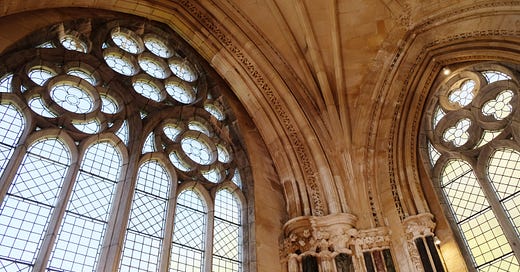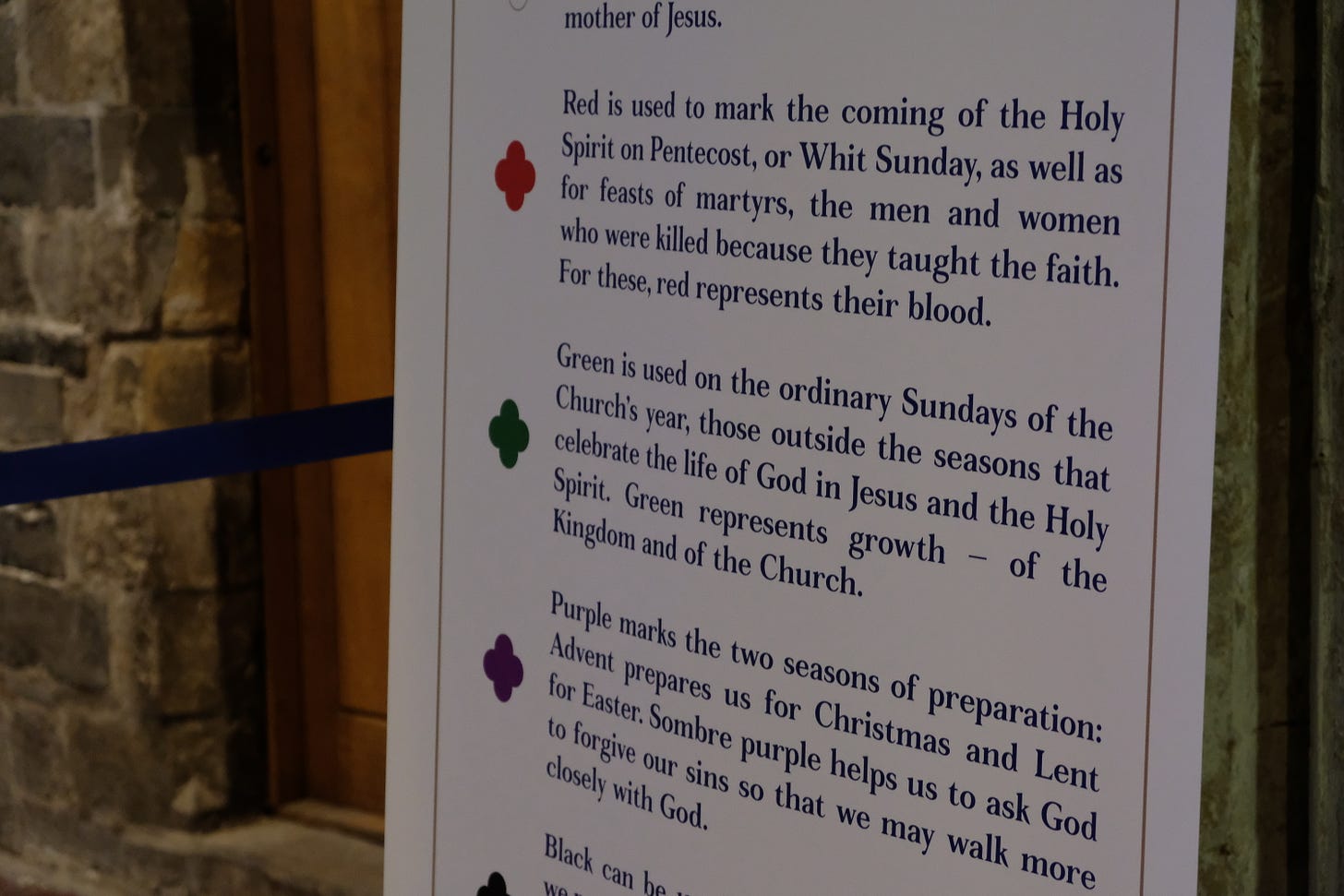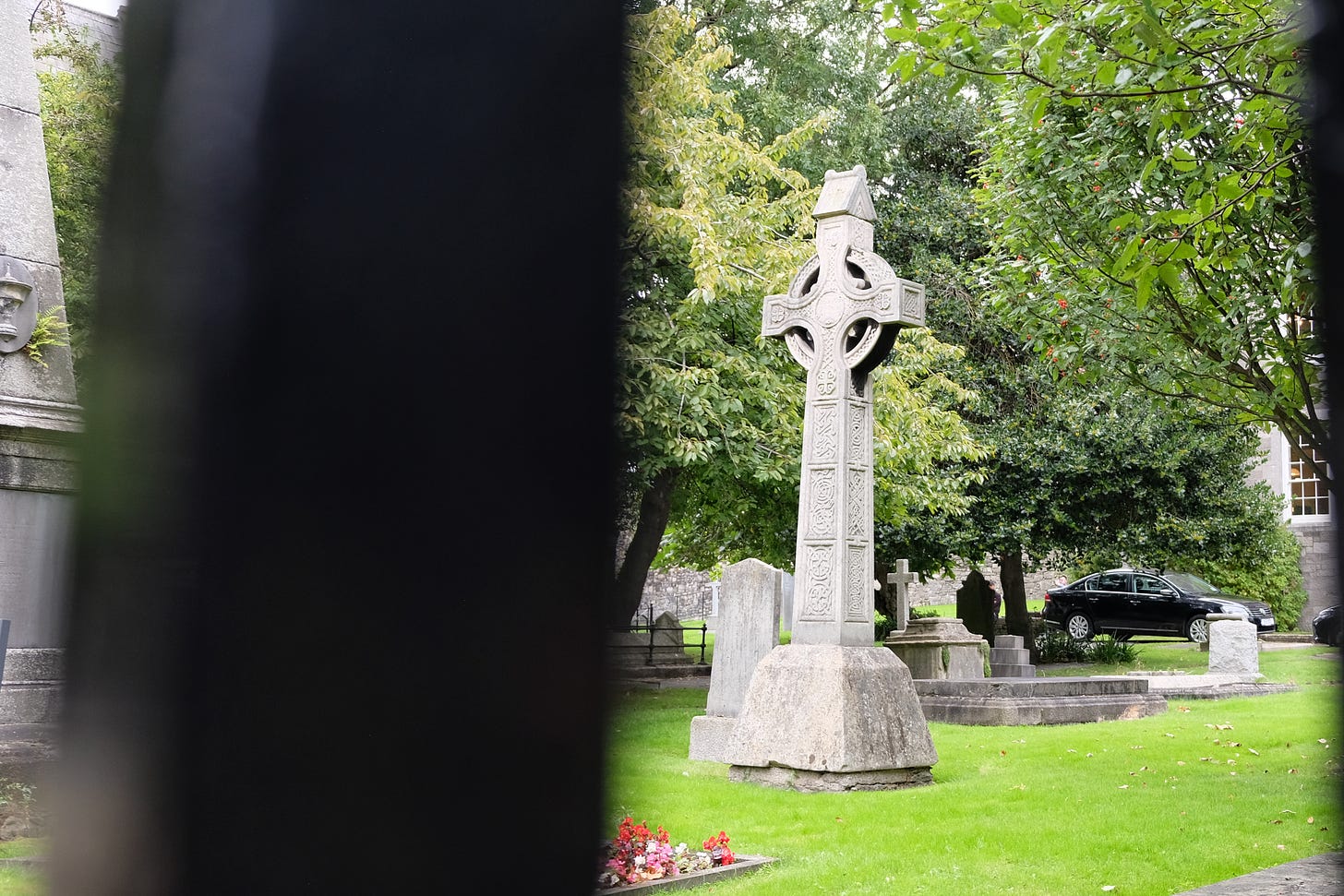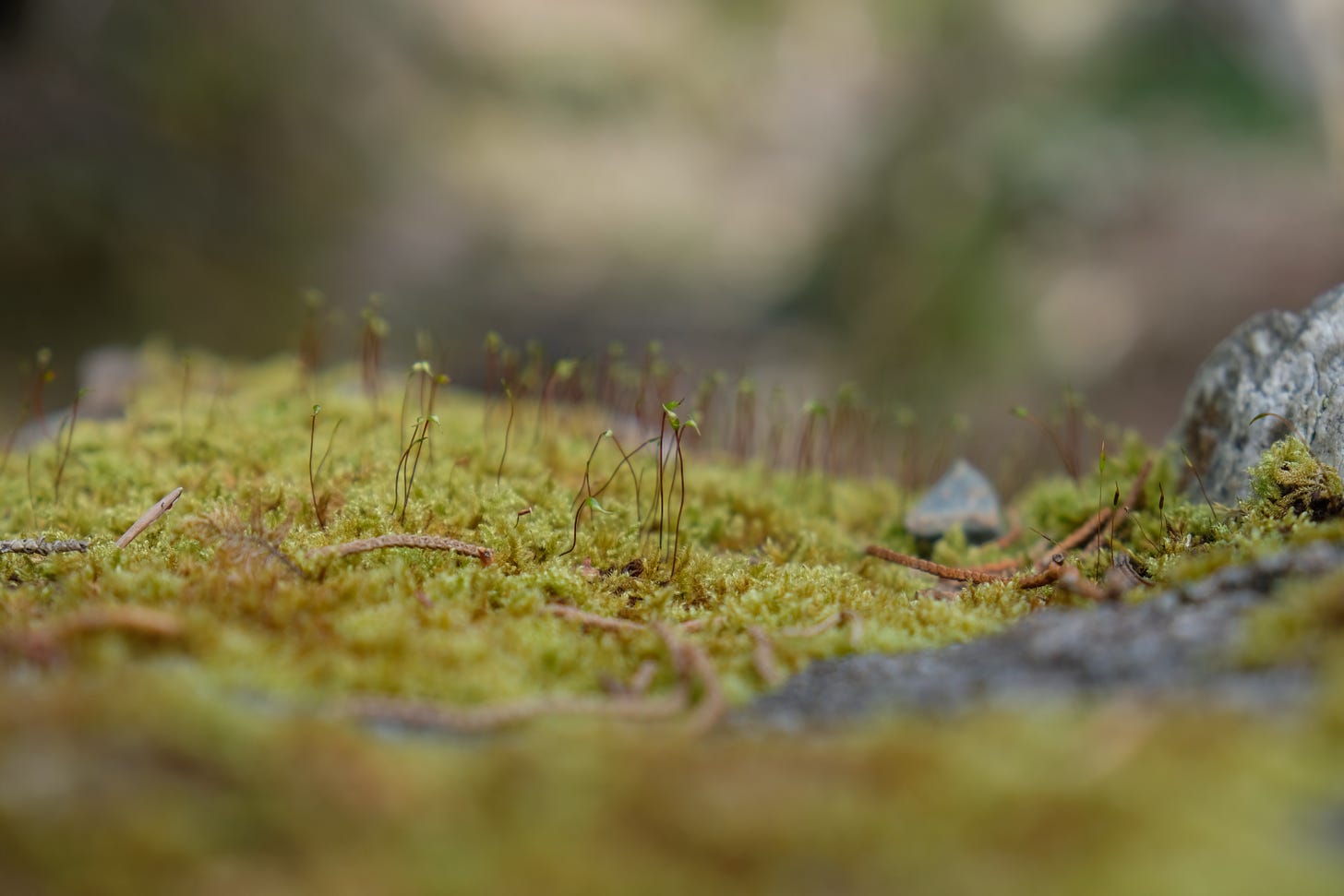Ireland is called the land of “40 shades of green,” and that seems like a gross underestimate. I scroll through photos from my trip and try to name the greens I see: moss, olive, sage, hunter, kelly. Language falls short. My eyes see what my mind can not name, and I am aware of the way infinite shades exist within a finite spectrum. I once heard a scientist insist colors are not real, in that our brains construct them as our eyes process light, and they do not exist outside our minds. I wonder if he’s ever been to Ireland.
St. Patrick’s Cathedral in Dublin is as much a museum as it is a place of worship. More than any other cathedral I’ve visited, it’s full of plaques and posters and interactive displays. In one area, I lay a piece of paper over a metal impression of St. Patrick himself, and I use the provided crayon to make a rubbing to take home. In another space, I pick up a phone and hear a recording of ringing church bells. Elsewhere, I come across a display of priestly garments and a poster explaining their symbolism. As I read, I’m reminded of something I know but hadn’t given much thought to lately: green is the color of Ordinary Time.
The church calendar is a circle, and the Christian new year falls on Advent—the four week period of anticipating and preparing for the birth of Christ. It then moves through the seasons of Christmas, Epiphany, Lent, Eastertide, and Pentecost, before landing back in Ordinary Time—this green season. The traditional colors associated with each wedge of the circle add another layer of meaning and symbolism, helping us forgetful humans remember what is true about God in any given time period. Purple reminds us of royalty, white of purification, gold of holiness and righteousness. Red of blood or fire, pink of joy.
Today is the first day of Advent, and this season of Holy Time will carry us all the way to Pentecost around Memorial Day. These many months are more-or-less a long line-up of holidays and feasts and celebrations or the days preparing for them. But up until yesterday, we were in the season of Ordinary Time—the longest season of the year.
Our church held its final Sunday service on Pentecost. Pentecost is a feast day, 50 days after Easter Sunday, on which Christians are meant to remember and celebrate the gift of the Holy Spirit, given to the early Jesus-followers. It’s also the day generally observed as the “birthday of the church,” but was, for my little community, a death.
We first visited Christ Church in August 2019, not long after moving to Indianapolis. A college friend, Indy-native, knew my spiritual journey well and recommended it, and she was right. Our family felt immediately at home. The service itself suited us. We made friends quickly. We started volunteering in children’s ministry. (When you attend a small church and bring your three children, it’s kind of the least you can do.) When we moved to Zoom at the start of the pandemic, I began coordinating a virtual kids’ worship and story time, and by the time we transitioned backed to in-person services, I had joined staff as the children’s ministry coordinator. Over time, my role grew and morphed and in the end I was the Director of Spiritual Formation. I was organizing small groups, planning teaching calendars, and even trying my hand at preaching. It was my job to think about our community’s spiritual needs and notice opportunities for growth and transformation, ever closer to the image and likeness of Jesus.
We moved into a new rental space, holding our Sunday gatherings in a light-filled gallery, worshiping with fine art surrounding us on all sides and a sculpture garden just beyond the doors. At the beginning of 2023, new people joined us every week.
And then everything fell to pieces.
On the final day of our Ireland trip, I sit down in a pew. I am in the chapel at Kylemore Abbey, somewhere in the Connemara National Park in County Galway. This entire church is constructed out of the richly-colored marble this region is known for, and it is beautiful.
Before arriving in Dublin six days ago, I had not stepped foot into a church building since Memorial Day weekend. The past week has afforded several opportunities to visit cathedrals, but this is the first time I’ve sat down.
My camera is heavy around my neck, and I lit the strap over my head and hold it in my lap instead. I crane my neck backward, and stare out the windows above me for a moment. I can’t see anything beyond them, but I let my eyes adjust to the brighter light. I take a deep breath, and I feel the pressure of coming tears form at the back of my eyes.
When our church closed its doors, I said we’d take some time over the summer to reevaluate. But as the weeks went on, I felt less and less sure that I wanted to return to “church” in this traditional Sunday-morning sense. There are hesitations and questions, of course, about what church community we’d even want to be a part of. When I am honest, I can admit to the lingering hurt from not just these most recent experiences but most churches I’ve ever attended. But more than that, I have a deep desire for something different—though I’m not sure what it is.
My middle son whined and complained about going to church every single Sunday. “It‘s boring,” he protested. (What a very rude thing to say to your mother, when she is also the children’s ministry director.)
Sometime in June, he asked, “When are we going back to Christ Church?” “Christ Church doesn’t exist anymore,” I reminded him. I thought the kids had understood when we said the church was closing.
“But I want to go.”
“I thought you didn’t like church,” I prod.
“Well, I don’t. But if we were going to church, Christ Church is the one I want to go to.”
I don’t say, “Me, too.” I want to leave open the possibility of somewhere new, somewhere different, somewhere better. But I don’t think that place exists.
So many times I told my children, “Church isn’t a building. The church is the people.” But our people aren’t exactly gone, and for that matter, neither is the building. So then, what? Church must, in fact, be something other than the people. Many of those people are now going to other churches—but we are not.
How do I explain institutions to my children? How do I explain what it feels like to hit the limits of my personal integrity? How do I say that after 10+ years as a church staffer I don’t know how to walk into these spaces as a guest? How do I explain that I loved my job but just couldn’t do it anymore? How do I say I don’t know if I’m supposed to lead or follow or participate or consume, to listen or to talk?
Back in the pew, I continue with my deep breaths. I continue staring up at the archways, the intricate windows, the three-toned marble columns. And in that moment, something shifts inside me. I do not hear a voice or get goosebumps or sense a wind moving around me. It’s more like the gentlest hand resting on my shoulder, like twisting and untwisting the lid on a jar until the grooves finally line up just right. In that moment, something inside me settles, and I am at peace.
Today is the first day of Advent—a season of waiting. I feel at home here, because waiting is what I’ve done through all of ordinary time. The tiniest sprout popped from the soil there in Connemara, and I am content to continue lingering here while she looks for the light.








This resonated with me. I am on a similar path in regards to church.
Will be praying for you all for the Lord to lead you.
I’m sorry your family has had to go through this kind of pain. I was just telling a new friend how even after 2 years at a new church that we love, I still feel a tender pain about the church we left in the middle of the pandemic. I know we’re where we supposed to be but sometimes I still feel lonely, and sometimes it still hurts. I hope you find a new place to gather with God’s people. I do think it’s worth the discomfort.